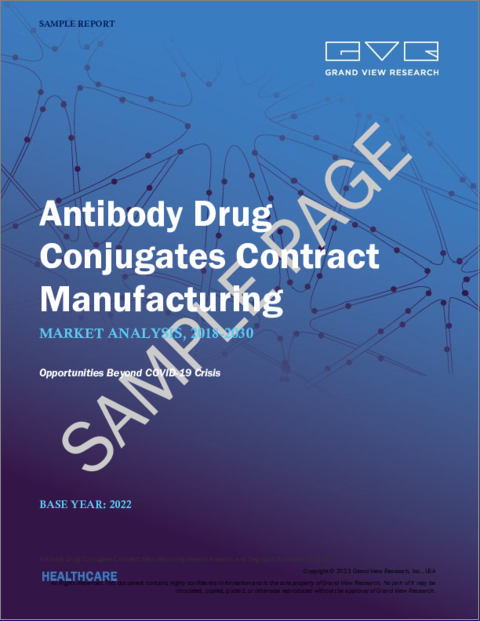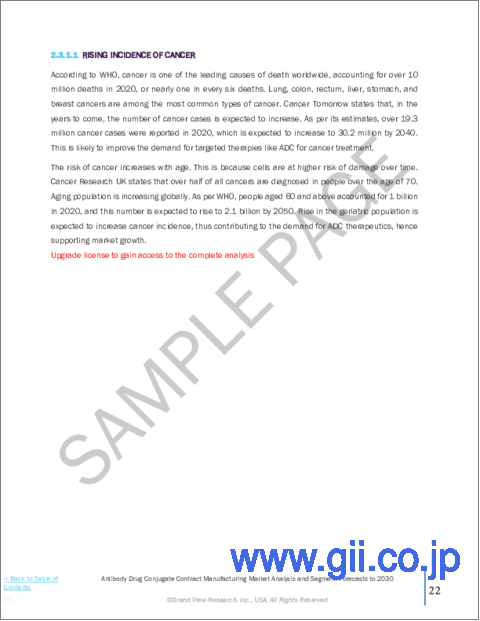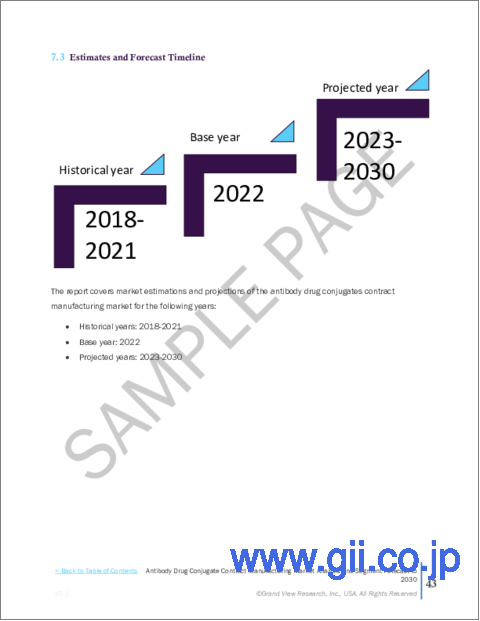|
|
市場調査レポート
商品コード
1171048
抗体薬物複合体 (ADC) 受託製造の市場規模、シェア、動向分析レポート:リンカー別(開裂型、非開裂型)、疾患別(骨髄腫、リンパ腫、乳がん)、地域別、セグメント別予測、2023年~2030年Antibody Drug Conjugates Contract Manufacturing Market Size, Share & Trends Analysis Report By Linker (Cleavable, Non-cleavable), By Condition (Myeloma, Lymphoma, Breast Cancer), By Region, And Segment Forecasts, 2023 - 2030 |
||||||
|
● お客様のご希望に応じて、既存データの加工や未掲載情報(例:国別セグメント)の追加などの対応が可能です。 詳細はお問い合わせください。 |
|||||||
| 抗体薬物複合体 (ADC) 受託製造の市場規模、シェア、動向分析レポート:リンカー別(開裂型、非開裂型)、疾患別(骨髄腫、リンパ腫、乳がん)、地域別、セグメント別予測、2023年~2030年 |
|
出版日: 2022年11月22日
発行: Grand View Research
ページ情報: 英文 130 Pages
納期: 2~10営業日
|
- 全表示
- 概要
- 図表
- 目次
抗体薬物複合体 (ADC) 受託製造市場の成長と動向
Grand View Research, Inc.の新しいレポートによると、世界の抗体薬物複合体 (ADC) 受託製造の市場規模は、予測期間中に12.9%のCAGRを記録し、2030年までに257億9000万米ドルに達すると予測されています。業界成長の要因としては、抗体薬物複合体(ADC)の複雑な性質が受託製造の需要に寄与していること、抗体治療に関する研究の増加、がんの罹患率の上昇などが挙げられます。パンデミック時には、がんに対する臨床試験が短期間停止されました。しかし、病気の深刻さにより、臨床試験は再び開始されました。IQVIA Oncology Trends Report 2022によると、がんの臨床試験の数は増加しています。
IQVIAのレポートによると、2016年から2021年の間に、腫瘍学の臨床試験は56%増加したとのことです。この臨床試験数は、世界のがんの有病率の増加により、さらに増加することが予想されます。これは、ADCの開発および製造活動をサポートするため、パンデミック後の業界の成長をサポートすると予想されます。抗体薬物複合体は、がん細胞のみを標的とし、体内の健康な細胞には影響を与えないため、がんの治療において高い効率性を発揮します。その結果、複数のバイオ医薬品企業がADC関連研究のために多額の資金を獲得しています。
例えば、2022年10月、Mablink Bioscience、抗体薬物複合体のパイプラインを構築するために、シリーズA資金から3100万米ドルを調達しています。このように、ADCの研究開発への多額の投資は、今後数年間でその利用可能性を向上させ、その結果、ADC受託製造の需要をサポートすると予想されます。2021年9月、米国FDAは、ADC tisotumab vedotin-tftvについて、病勢進行した再発または転移性子宮頸がんの成人患者または化学療法後の治療に加速承認を与えました。今後数年間は、このような承認により、ADCの受託製造サービスの需要が高まると予想されます。
抗体薬物複合体 (ADC) 受託製造市場のレポートハイライト
疾患別では、リンパ腫のセグメントが予測期間中に最も速いCAGRで成長すると予想される
リンパ腫向けに開発中の多数のADCと、リンパ腫向けのADC関連研究のための共同研究が、予測期間中の同セグメントの成長を支えている
リンカーに基づくと、2022年には開裂型リンカーセグメントが全体の収益の最大シェアを占めた
ADCにおける開裂型リンカー技術の広範な使用と、パイプラインにある開裂型リンカーベースの製品の数の多さが、セグメント成長の要因となっている
2022年、アジア太平洋地域は世界の業界を支配し、最大の収益シェアを占めた
これは、新興国市場における研究開発活動の堅調な改善と、先進国と比較して同地域の製造コストが低いことに起因している
目次
第1章 調査手法と範囲
- 市場セグメンテーションと範囲
- 調子
- リンカ
- 地域範囲
- 調査手法
- 情報調達
- 購入したデータベース
- GVRの内部データベース
- 二次情報
- 1次調査
- 1次調査内容
- 情報またはデータ分析
- データ分析モデル
- 市場の策定と検証
- モデルの詳細
- コモディティフロー分析(モデル1)
- アプローチ1:コモディティフローアプローチ
- コモディティフロー分析(モデル1)
- 二次情報一覧
- 一次情報のリスト
- 目的
第2章 エグゼクティブサマリー
- 市場の見通し
第3章 抗体薬物複合体 (ADC) 受託製造市場の変数、動向、範囲
- 市場系列の見通し
- 親会社の市場見通し
- 関連/補助的な市場の見通し
- 市場力学
- 市場促進要因分析
- がんの発生率の上昇
- ADCの製造コストが高く、製造に関連する課題が受託製造の需要に貢献している
- ADCの研究開発活動の増加
- 市場抑制要因分析
- 外注時の品質問題
- 大手バイオ医薬品企業が選択した限定的なアウトソーシング
- 市場促進要因分析
- 抗体医薬品コンジュゲート受託製造市場分析ツール
- ポーターのファイブフォース分析
- PESTLE分析
- 主要取引と戦略的提携分析
- 合併と買収
- 拡張
- 契約とコラボレーション
- 製品とサービスの発売
- COVID-19の影響と改革戦略
第4章 抗体薬物複合体 (ADC) 受託製造市場:状態推定・動向分析
- 定義と範囲
- 抗体薬物複合体 (ADC) 受託製造市場シェア、2022年および2030年
- 骨髄腫
- リンパ腫
- 乳がん
- その他
第5章 抗体薬物複合体 (ADC) 受託製造市場:リンカーの推定・動向分析
- 定義と範囲
- 抗体薬物複合体 (ADC) 受託製造市場シェア、2022年および2030年
- 切断可能なリンカー
- 切断不可能なリンカー
第6章 抗体薬物複合体 (ADC) 受託製造市場:地域の推定・動向分析
- 地域市場シェア分析、2022年および2030年
- 北米
- 米国
- カナダ
- 欧州
- 英国
- ドイツ
- フランス
- イタリア
- スペイン
- デンマーク
- スウェーデン
- ノルウェー
- アジア太平洋地域
- 日本
- 中国
- インド
- オーストラリア
- タイ
- 韓国
- ラテンアメリカ
- ブラジル
- メキシコ
- アルゼンチン
- MEA
- 南アフリカ
- サウジアラビア
- アラブ首長国連邦
- クウェート
第7章 競合分析
- 主要な市場参入企業別最近の開発と影響分析
- 企業/競合の分類(主要なイノベーター、マーケットリーダー、新興企業)
- 参加者の分類
第8章 競合情勢
- 企業プロファイル
- Recipharm AB
- 会社概要
- 財務実績
- サービスのベンチマーク
- 戦略的イニシアチブ
- Samsung Biologics
- 会社概要
- 財務実績
- サービスのベンチマーク
- 戦略的イニシアチブ
- Lonza
- 会社概要
- 財務実績
- サービスのベンチマーク
- 戦略的イニシアチブ
- Piramal Group(Piramal Pharma Solutions)
- 会社概要
- 財務実績
- サービスのベンチマーク
- 戦略的イニシアチブ
- Sterling
- 会社概要
- 財務実績
- サービスのベンチマーク
- 戦略的イニシアチブ
- Sartorius AG
- 会社概要
- 財務実績
- サービスのベンチマーク
- 戦略的イニシアチブ
- Catalent, Inc
- 会社概要
- 財務実績
- サービスのベンチマーク
- 戦略的イニシアチブ
- Wuxi Biologics
- 会社概要
- 財務実績
- サービスのベンチマーク
- 戦略的イニシアチブ
- AbbVie, Inc.(AbbVie Contract Manufacturing)
- 会社概要
- 財務実績
- サービスのベンチマーク
- 戦略的イニシアチブ
- Merck KGaA
- 会社概要
- 財務実績
- サービスのベンチマーク
- 戦略的イニシアチブ
- Recipharm AB
List of Tables
- Table 1 List of secondary sources
- Table 2 List of Abbreviations
List of Figures
- Fig 1 Market research process
- Fig. 2 Information procurement
- Fig. 3 Primary research pattern
- Fig. 4 Market research approaches
- Fig. 5 Value-chain-based sizing & forecasting
- Fig. 6 QFD modeling for market share assessment
- Fig. 7 Market formulation & validation
- Fig. 8 Commodity flow analysis
- Fig. 9 Volume Price Analysis
- Fig. 10 Antibody drug conjugates contract manufacturing market snapshot (2022)
- Fig. 11 Antibody drug conjugates contract manufacturing market segmentation
- Fig. 12 Market driver relevance analysis (Current & future impact)
- Fig. 13 Market restraint relevance analysis (Current & future impact)
- Fig. 14 Penetration & growth prospect mapping
- Fig. 15 Porter's five forces analysis
- Fig. 16 SWOT analysis, by factor (political & legal, economic and technological)
- Fig. 17 Antibody drug conjugates contract manufacturing market condition outlook: Segment dashboard
- Fig. 18 Antibody drug conjugates contract manufacturing market: Condition movement analysis
- Fig. 19 Myeloma market (USD Million)
- Fig. 20 Lymphoma market (USD Million)
- Fig. 21 Breast Cancer market (USD Million)
- Fig. 22 Others market (USD Million)
- Fig. 23 Antibody drug conjugates contract manufacturing market linker outlook: Segment dashboard
- Fig. 24 Antibody drug conjugates contract manufacturing market: Linker movement analysis
- Fig. 25 Cleavable Linker market (USD Million)
- Fig. 26 Non-Clevable Linker market (USD Million)
- Fig. 27 Regional market: Key takeaways
- Fig. 28 Regional outlook, 2022 & 2030
- Fig. 29 North America market, 2018 - 2030 (USD Million)
- Fig. 30 U.S. market, 2018 - 2030 (USD Million)
- Fig. 31 Canada Market, , 2018 -2030 (USD Million)
- Fig. 32 Europe Market, , 2018 -2030 (USD Million)
- Fig. 33 U.K. Market, , 2018 -2030 (USD Million)
- Fig. 34 Germany Market, , 2018 -2030 (USD Million)
- Fig. 35 France Market, , 2018 -2030 (USD Million)
- Fig. 36 Italy Market, 2018 -2030 (USD Million)
- Fig. 37 SpainMarket, 2018 -2030 (USD Million)
- Fig. 38 Denmark Market, 2018 -2030 (USD Million)
- Fig. 39 SwedenMarket, 2018 -2030 (USD Million)
- Fig. 40 Norway Market, By Service, 2018 -2030 (USD Million)
- Fig. 41 Asia Pacific market, 2018 - 2030 (USD Million)
- Fig. 42 China market, 2018 - 2030 (USD Million)
- Fig. 43 India market, 2018 - 2030 (USD Million)
- Fig. 44 Japan market, 2018 - 2030 (USD Million)
- Fig. 45 Australia market, 2018 - 2030 (USD Million)
- Fig. 46 Thailand market, 2018 - 2030 (USD Million)
- Fig. 47 South Korea market, 2018 - 2030 (USD Million)
- Fig. 48 Latin America market, 2018 - 2030 (USD Million)
- Fig. 49 Brazil market, 2018 - 2030 (USD Million)
- Fig. 50 Mexico market, 2018 - 2030 (USD Million)
- Fig. 51 Argentina market, 2018 - 2030 (USD Million)
- Fig. 52 MEA market, 2018 - 2030 (USD Million)
- Fig. 53 South Africa market, 2018 - 2030 (USD Million)
- Fig. 54 Saudi Arabia market, 2018 - 2030 (USD Million)
- Fig. 55 UAE market, 2018 - 2030 (USD Million)
- Fig. 56 Kuwait market, 2018 - 2030 (USD Million)
Antibody Drug Conjugates Contract Manufacturing Market Growth & Trends:
The global antibody drug conjugates contract manufacturing market size is expected to reach USD 25.79 billion by 2030, registering a CAGR of 12.9% over the forecast period, according to a new report by Grand View Research, Inc. The factors driving the industry growth include the complex nature of antibody drug conjugates (ADCs) contributing to the demand for contract manufacturing, the increasing number of research on antibody therapies, and the rise in cancer incidence. During the pandemic, the clinical trials for cancer were stopped for a short period. However, owing to the severity of the disease, the trials were started again. As per the IQVIA Oncology Trends Report 2022, the number of clinical trials for cancer is growing.
The IQVIA report states that there was a 56% increase in oncology clinical trials between 2016 and 2021. This number of clinical studies is expected to rise even further owing to the growing prevalence of cancer worldwide. This is expected to support the ADC development and manufacturing activities, thus supporting industry growth post-pandemic. Antibody drug conjugates have high efficiency in treating cancer as it only targets the cancerous cells and does not affect the healthy cells of the body. As a result, several biopharmaceutical companies have received significant funding for ADC-related research.
For instance, in October 2022, Mablink Bioscience, raise USD 31 million from Series A funding to build its antibody drug conjugate pipeline. Thus, heavy investments in the R&D of ADCs are expected to improve their availability in the coming years and thus support the demand for ADC contract manufacturing. In September 2021, the U.S. FDA provided accelerated approval for ADC tisotumab vedotin-tftv for treating adult patients with recurrent or metastatic cervical cancer with disease progression or after chemotherapy. Such approvals, in the coming years, are expected to boost the demand for contract manufacturing services for ADC.
Antibody Drug Conjugates Contract Manufacturing Market Report Highlights:
- By condition, the lymphoma segment is expected to grow at the fastest CAGR over the forecast period
- A significant number of ADCs under development for lymphoma and collaborations for ADC-related research for lymphoma are supporting the growth of the segment over the forecast period
- Based on the linker, the cleavable linker segment accounted for the maximum share of the overall revenue in 2022
- Extensive use of cleavable linker technology in ADC and a greater number of cleavable linker-based products in the pipeline are the factors responsible for the segment growth
- Asia Pacific dominated the global industry in 2022 and accounted for the maximum revenue share
- This is due to the robust improvements in R&D activities in emerging markets and low-cost manufacturing in the region as compared to that of developed countries
Table of Contents
Chapter 1. Methodology and Scope
- 1.1. Market Segmentation & Scope
- 1.1.1. Condition
- 1.1.2. Linker
- 1.1.3. Regional scope
- 1.1.4. Estimates and forecast timeline
- 1.2. Research Methodology
- 1.3. Information Procurement
- 1.3.1. Purchased database
- 1.3.2. GVR's internal database
- 1.3.3. Secondary sources
- 1.3.4. Primary research
- 1.3.5. Details of primary research
- 1.4. Information or Data Analysis
- 1.4.1. Data analysis models
- 1.5. Market Formulation & Validation
- 1.6. Model Details
- 1.6.1. Commodity flow analysis (Model 1)
- 1.6.1.1. Approach 1: Commodity flow approach
- 1.6.1. Commodity flow analysis (Model 1)
- 1.7. List of Secondary Sources
- 1.8. List of Primary Sources
- 1.9. Objectives
- 1.9.1. Objective 1
- 1.9.2. Objective 2
Chapter 2. Executive Summary
- 2.1. Market Outlook
Chapter 3. Antibody Drug Conjugates Contract Manufacturing Market Variables, Trends & Scope
- 3.1. Market Lineage Outlook
- 3.1.1. Parent market outlook
- 3.1.2. Related/ancillary market outlook
- 3.2. Market Dynamics
- 3.2.1. Market driver analysis
- 3.2.1.1. Rising incidence of cancer
- 3.2.1.2. High cost of manufacturing ADC and challenges associated with manufacturing contributing to the demand for contract manufacturing
- 3.2.1.3. Increasing R&D activities on ADCs
- 3.2.2. Market restraint analysis
- 3.2.2.1. Quality issues while outsourcing
- 3.2.2.2. Limited outsourcing opted by big biopharma Companies
- 3.2.1. Market driver analysis
- 3.3. Antibody Drug Conjugates Contract Manufacturing Market Analysis Tools
- 3.3.1. Porter's Five Forces Analysis
- 3.3.2. PESTLE Analysis
- 3.3.3. Major Deals & Strategic Alliances Analysis
- 3.3.3.1. Mergers and acquisition
- 3.3.3.2. Expansions
- 3.3.3.3. Agreements and collaborations
- 3.3.3.4. Product and service launches
- 3.4. Covid-19 Impact and Reformation Strategy
Chapter 4. Antibody Drug Conjugates Contract Manufacturing Market: Condition Estimates & Trend Analysis
- 4.1. Definitions and Scope
- 4.2. Antibody Drug Conjugates Contract Manufacturing Market Share, 2022 & 2030
- 4.3. Myeloma
- 4.3.1. Myeloma market estimates and forecast 2018 to 2030 (USD Million)
- 4.4. Lymphoma
- 4.4.1. Lymphoma market estimates and forecast 2018 to 2030 (USD Million)
- 4.5. Breast Cancer
- 4.5.1. Breast Cancer market estimates and forecast 2018 to 2030 (USD Million)
- 4.6. Others
- 4.6.1. Others market estimates and forecast 2018 to 2030 (USD Million)
Chapter 5. Antibody Drug Conjugates Contract Manufacturing Market: Linker Estimates & Trend Analysis
- 5.1. Definitions and Scope
- 5.2. Antibody Drug Conjugates Contract Manufacturing Market Share, 2022 & 2030
- 5.3. Cleavable linker
- 5.3.1. Cleavable linker market estimates and forecast 2018 to 2030 (USD Million)
- 5.4. Non-cleavable linker
- 5.4.1. Non-cleavable linker market estimates and forecast 2018 to 2030 (USD Million)
Chapter 6. Antibody Drug Conjugates Contract Manufacturing Market: Regional Estimates & Trend Analysis
- 6.1. Regional market share analysis, 2022 & 2030
- 6.2. North America
- 6.2.1. U.S.
- 6.2.1.1. U.S. market estimates and forecast, 2018 - 2030
- 6.2.2. Canada
- 6.2.2.1. Canada market estimates and forecast, 2018 - 2030
- 6.2.1. U.S.
- 6.3. Europe
- 6.3.1. U.K.
- 6.3.1.1. U.K. market estimates and forecast, 2018 - 2030
- 6.3.2. Germany
- 6.3.2.1. Germany market estimates and forecast, 2018 - 2030
- 6.3.3. France
- 6.3.3.1. France market estimates and forecast, 2018 - 2030
- 6.3.4. Italy
- 6.3.4.1. Italy market estimates and forecast, 2018 - 2030
- 6.3.5. Spain
- 6.3.5.1. Spain market estimates and forecast, 2018 - 2030
- 6.3.6. Denmark
- 6.3.6.1. Denmark market estimates and forecast, 2018 - 2030
- 6.3.7. Sweden
- 6.3.7.1. Sweden market estimates and forecast, 2018 - 2030
- 6.3.8. Norway
- 6.3.8.1. Norway market estimates and forecast, 2018 - 2030
- 6.3.1. U.K.
- 6.4. Asia Pacific
- 6.4.1. Japan
- 6.4.1.1. Japan market estimates and forecast, 2018 - 2030
- 6.4.2. China
- 6.4.2.1. China market estimates and forecast, 2018 - 2030
- 6.4.3. India
- 6.4.3.1. India market estimates and forecast, 2018 - 2030
- 6.4.4. Australia
- 6.4.4.1. Australia market estimates and forecast, 2018 - 2030
- 6.4.5. Thailand
- 6.4.5.1. Thailand market estimates and forecast, 2018 - 2030
- 6.4.6. South Korea
- 6.4.6.1. South Korea market estimates and forecast, 2018 - 2030
- 6.4.1. Japan
- 6.5. Latin America
- 6.5.1. Brazil
- 6.5.1.1. Brazil market estimates and forecast, 2018 - 2030
- 6.5.2. Mexico
- 6.5.2.1. Mexico market estimates and forecast, 2018 - 2030
- 6.5.3. Argentina
- 6.5.3.1. Argentina market estimates and forecast, 2018 - 2030
- 6.5.1. Brazil
- 6.6. MEA
- 6.6.1. South Africa
- 6.6.1.1. South Africa market estimates and forecast, 2018 - 2030
- 6.6.2. Saudi Arabia
- 6.6.2.1. Saudi Arabia market estimates and forecast, 2018 - 2030
- 6.6.3. UAE
- 6.6.3.1. UAE market estimates and forecast, 2018 - 2030
- 6.6.4. Kuwait
- 6.6.4.1. Kuwait market estimates and forecast, 2018 - 2030
- 6.6.1. South Africa
Chapter 7. Competitive Analysis
- 7.1. Recent Developments & Impact Analysis, By Key Market Participant
- 7.2. Company/Competition Categorization (Key Innovators, Market Leaders, Emerging Players)
- 7.3. Participant Categorization
Chapter 8. Competitive Landscape
- 8.1. Company Profiles
- 8.1.1. Recipharm AB
- 8.1.1.1. Company overview
- 8.1.1.2. Financial performance
- 8.1.1.3. Service benchmarking
- 8.1.1.4. Strategic initiatives
- 8.1.2. Samsung Biologics
- 8.1.2.1. Company overview
- 8.1.2.2. Financial performance
- 8.1.2.3. Service benchmarking
- 8.1.2.4. Strategic initiatives
- 8.1.3. Lonza
- 8.1.3.1. Company overview
- 8.1.3.2. Financial performance
- 8.1.3.3. Service benchmarking
- 8.1.3.4. Strategic initiatives
- 8.1.4. Piramal Group (Piramal Pharma Solutions)
- 8.1.4.1. Company overview
- 8.1.4.2. Financial performance
- 8.1.4.3. Service benchmarking
- 8.1.4.4. Strategic initiatives
- 8.1.5. Sterling
- 8.1.5.1. Company overview
- 8.1.5.2. Financial performance
- 8.1.5.3. Service benchmarking
- 8.1.5.4. Strategic initiatives
- 8.1.6. Sartorius AG
- 8.1.6.1. Company overview
- 8.1.6.2. Financial performance
- 8.1.6.3. Service benchmarking
- 8.1.6.4. Strategic initiatives
- 8.1.7. Catalent, Inc
- 8.1.7.1. Company overview
- 8.1.7.2. Financial performance
- 8.1.7.3. Service benchmarking
- 8.1.7.4. Strategic initiatives
- 8.1.8. Wuxi Biologics
- 8.1.8.1. Company overview
- 8.1.8.2. Financial performance
- 8.1.8.3. Service benchmarking
- 8.1.8.4. Strategic initiatives
- 8.1.9. AbbVie, Inc. (AbbVie Contract Manufacturing)
- 8.1.9.1. Company overview
- 8.1.9.2. Financial performance
- 8.1.9.3. Service benchmarking
- 8.1.9.4. Strategic initiatives
- 8.1.10. Merck KGaA
- 8.1.10.1. Company overview
- 8.1.10.2. Financial performance
- 8.1.10.3. Service benchmarking
- 8.1.10.4. Strategic initiatives
- 8.1.1. Recipharm AB




